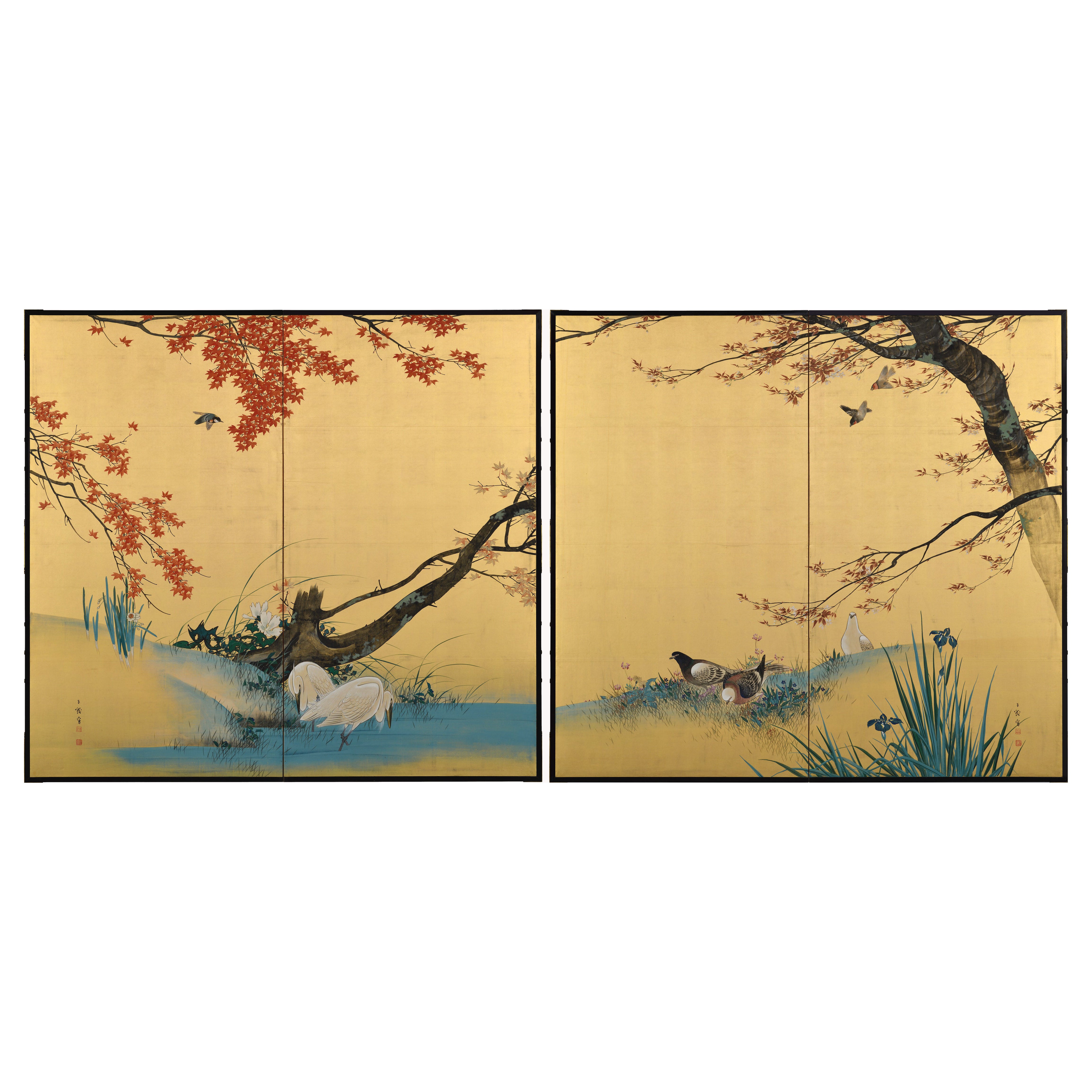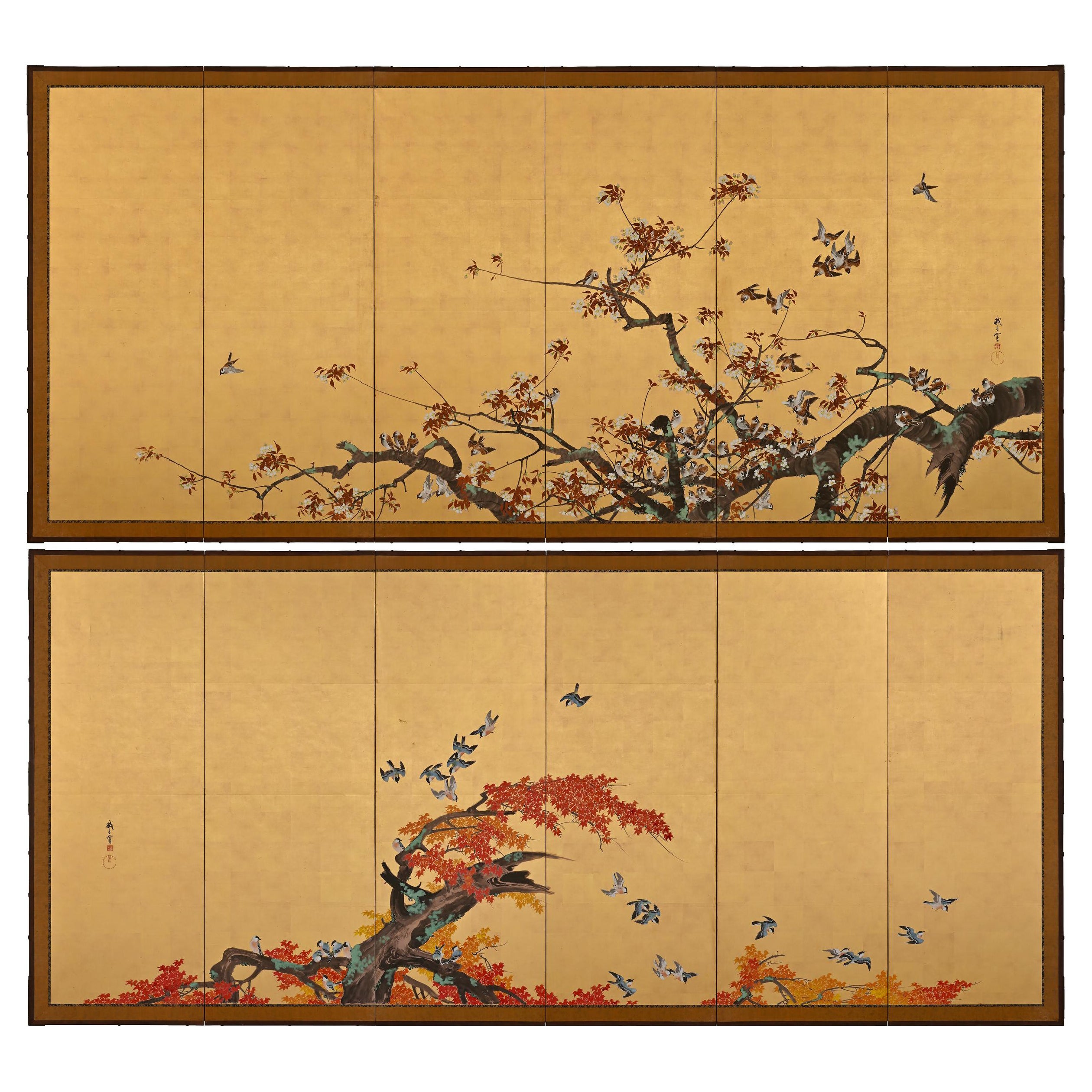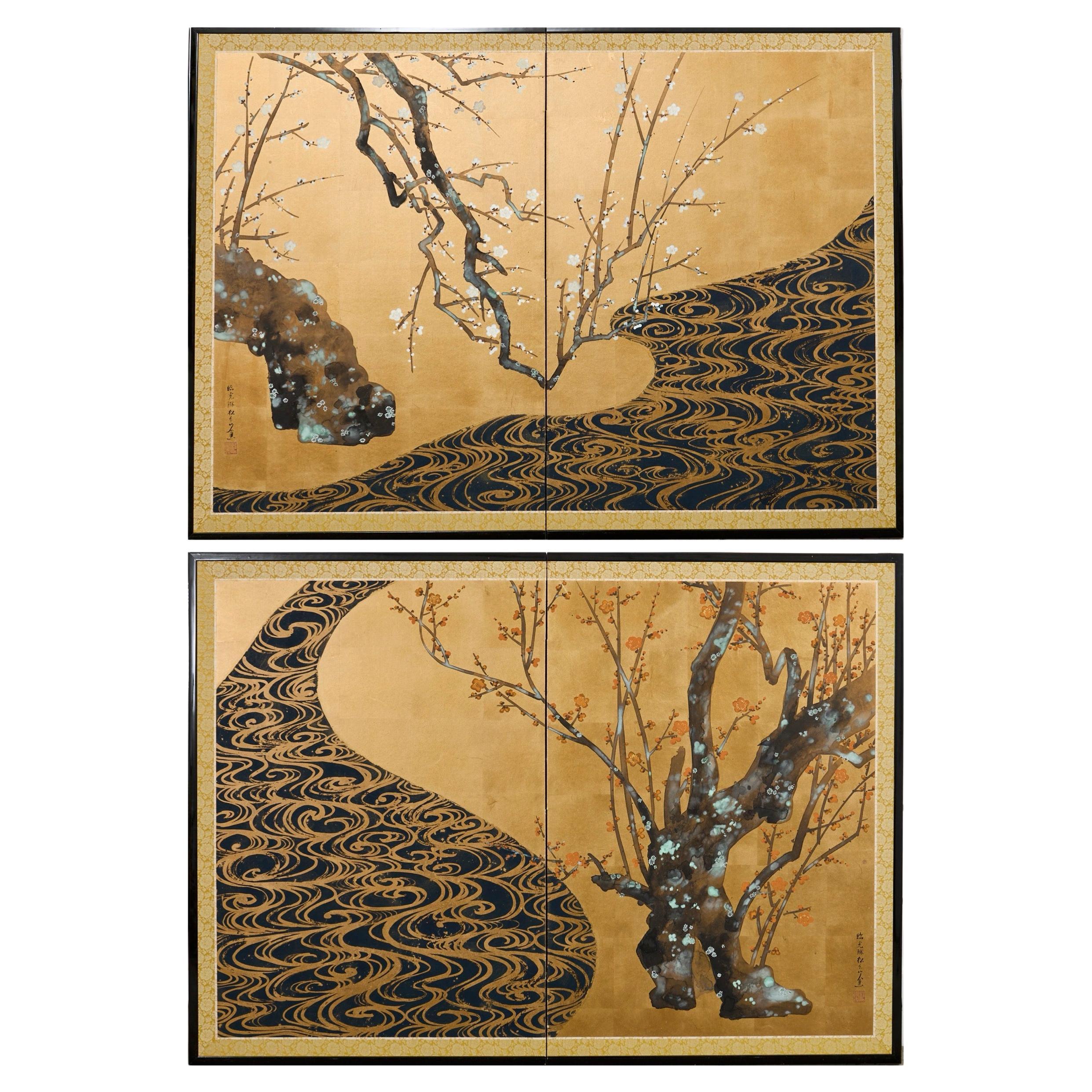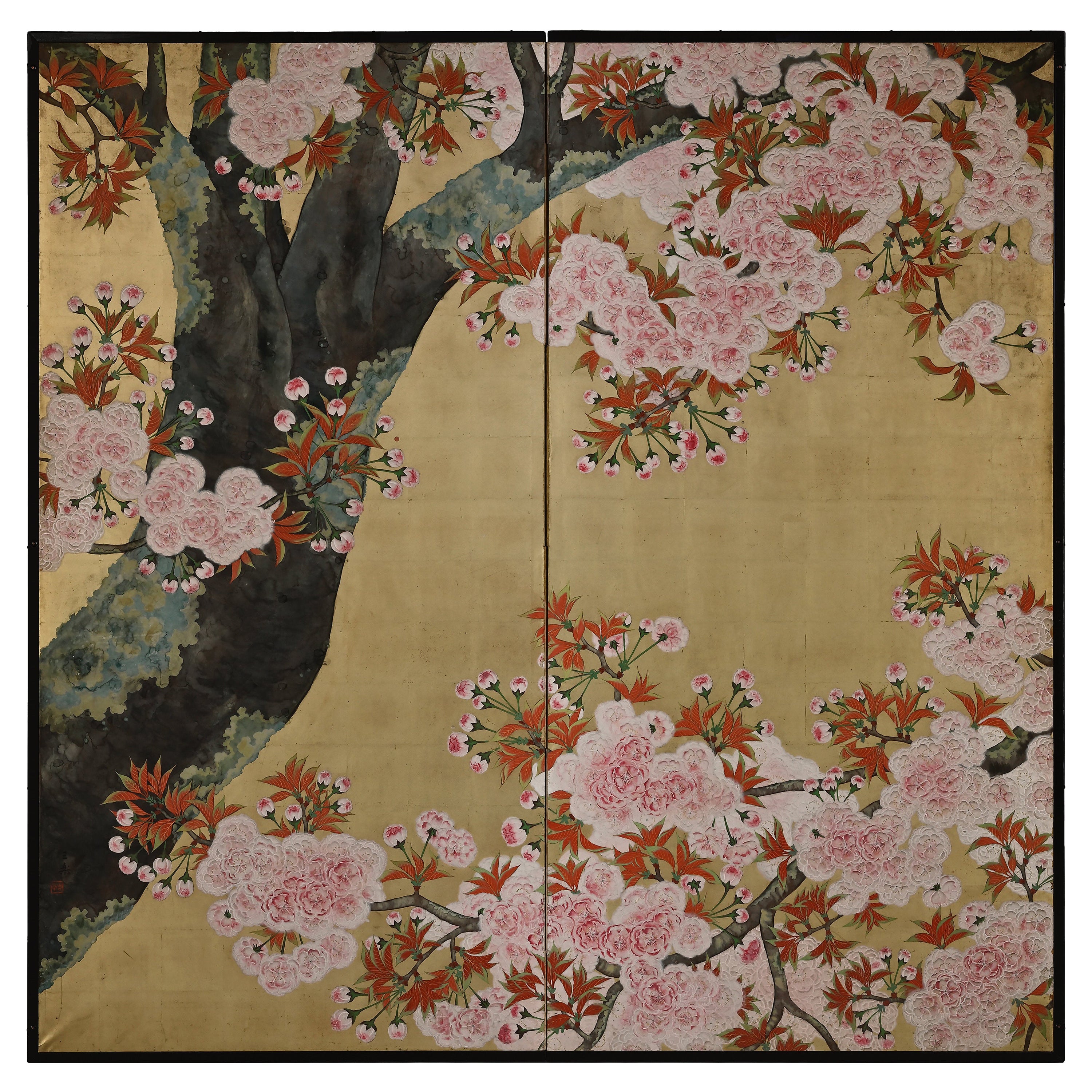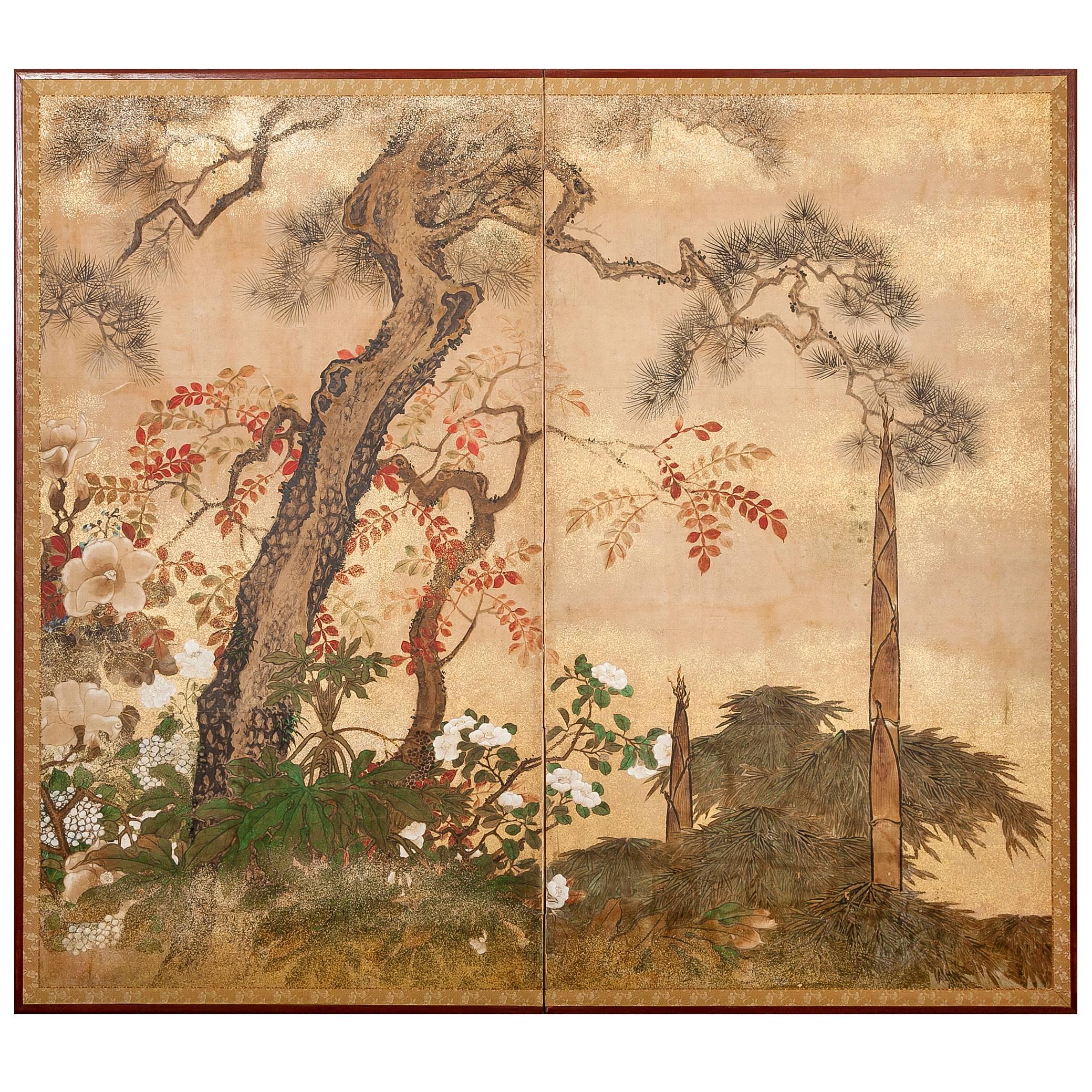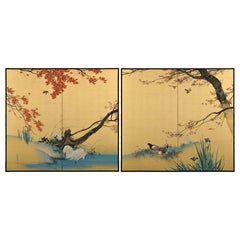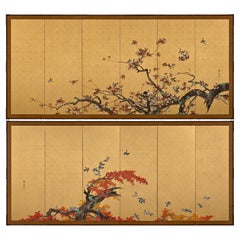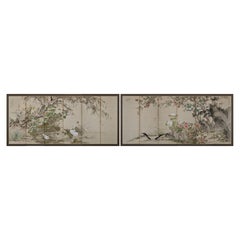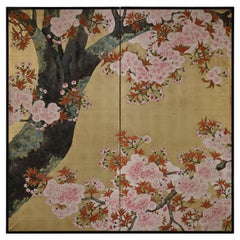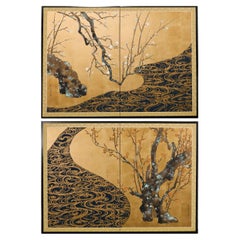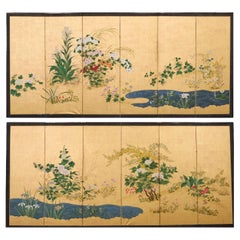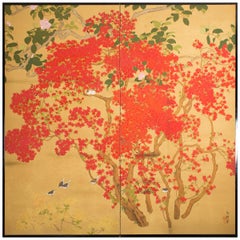Items Similar to 1895 Meiji Japanese Screen Pair. Cherry Blossoms & Autumn Maples on Silver Leaf
Want more images or videos?
Request additional images or videos from the seller
1 of 13
1895 Meiji Japanese Screen Pair. Cherry Blossoms & Autumn Maples on Silver Leaf
$32,000per set
£24,811.85per set
€28,153.70per set
CA$45,870.62per set
A$49,877.77per set
CHF 26,280.72per set
MX$605,870.21per set
NOK 330,401.66per set
SEK 309,724.88per set
DKK 211,268.93per set
About the Item
Cherry Blossoms and Autumn Maples
Isobe Hyakurin (1836–1906)
Dated Meiji 28, April: 1895
Pair of two-panel Japanese screens; ink and pigments on silver leaf
This refined pair of screens by Isobe Hyakurin, a Shinto priest and painter of the Maruyama–Shijō school, captures the passage of time through the changing seasons. The right screen depicts spring cherry blossoms with two delicate butterflies in flight; the left shows autumn maple branches and a pair of small birds. This transition is bridged by a field of shimmering silver leaf, an abstract void where moments in time are held suspe nded between vivid change and quiet stillness.
The composition achieves a masterful balance between fullness and emptiness. The branches on each screen reach toward the center, subtly echoing one another, yet they never meet. This measured tension creates a poetic dialogue between vitality and stillness — a visual metaphor for the continuity of nature’s cycles.
Hyakurin’s use of color is both restrained and expressive. The deep crimson and russet tones of the maple leaves resonate with the pale pink and white hues of the cherry blossoms, their contrast heightened by the cool radiance of the silver ground. Over time, the silver leaf gently oxidizes, softening into warmer shades of gray, lending the work an ever-changing atmospheric quality that mirrors the impermanence of the seasons it portrays.
In this work Hyakurin upholds the naturalistic yet idealized sensibility of the Maruyama–Shijō tradition, emphasizing keen observation and emotional restraint and distilling traditional painting into its purest elements: line, air, and light.
Isobe Hyakurin (1836–1906) was a Shinto priest and painter of the Maruyama–Shijō school. Born into a family that had served as priests at the Ise Grand Shrine for generations, he initially studied painting under Hayashi Sōrin, and later under Hasegawa Gyokuho in Kyoto. There, he refined the elegant style characteristic of the Maruyama–Shijō school and developed friendships with leading Kyoto artists such as Kubota Beisen, Imao Keinen, and Suzuki Shōnen.
After returning to Ise, Hyakurin resumed his duties as a priest while continuing to paint, earning top prizes at numerous exhibitions and gaining widespread recognition. Around 1877, during a movement to incorporate former master positions into the samurai class, he was approached several times by the head of the Uji clan to sign in support of the effort. Hyakurin firmly declined, declaring, “I live in my studio by the Isuzu River, with a brush at my side; my love of natural beauty is my true talent.”
His artistic achievements were widely celebrated—he received a bronze medal at the Kyoto Exposition and a gold medal at the Oriental Painting Exhibition. In 1905, during an imperial visit to Ise, he presented the Meiji Emperor with his painting Futamigaura-no-e. Hyakurin also played a pivotal role in nurturing a new generation of artists who would go on to shape the modern Kyoto art world.
He passed away in 1906, leaving behind a poignant farewell poem:
“Katachi koso kiyure, inochi wa no ni yama ni”
(While my form may pass away, my life flows into the fields and mountains.)
- Dimensions:Height: 68 in (172.72 cm)Width: 69 in (175.26 cm)Depth: 0.75 in (1.91 cm)
- Sold As:Set of 2
- Style:Meiji (Of the Period)
- Materials and Techniques:
- Place of Origin:
- Period:
- Date of Manufacture:1895
- Condition:Wear consistent with age and use.
- Seller Location:Kyoto, JP
- Reference Number:1stDibs: LU2472347049672
About the Seller
5.0
Recognized Seller
These prestigious sellers are industry leaders and represent the highest echelon for item quality and design.
Established in 2001
1stDibs seller since 2016
73 sales on 1stDibs
Typical response time: 7 hours
- ShippingRetrieving quote...Shipping from: Kyoto, Japan
- Return Policy
Authenticity Guarantee
In the unlikely event there’s an issue with an item’s authenticity, contact us within 1 year for a full refund. DetailsMoney-Back Guarantee
If your item is not as described, is damaged in transit, or does not arrive, contact us within 7 days for a full refund. Details24-Hour Cancellation
You have a 24-hour grace period in which to reconsider your purchase, with no questions asked.Vetted Professional Sellers
Our world-class sellers must adhere to strict standards for service and quality, maintaining the integrity of our listings.Price-Match Guarantee
If you find that a seller listed the same item for a lower price elsewhere, we’ll match it.Trusted Global Delivery
Our best-in-class carrier network provides specialized shipping options worldwide, including custom delivery.More From This Seller
View AllMeiji era Japanese Screen Pair, Two-panel. Spring & Autumn Birds & Flowers.
Located in Kyoto, JP
Spring and Autumn Birds & Flowers
Hasegawa Gyokujun (1863-1921)
Meiji period, circa 1900.
Ink, color and gofun on silk.
Dimensions of each screen:
H. 172 cm x W. 188 cm (68’’ x 7...
Category
Early 20th Century Japanese Meiji Paintings and Screens
Materials
Gold Leaf
Meiji Era, Circa 1900 Japanese Screen Pair, Flowers & Birds of Spring & Autumn
Located in Kyoto, JP
Flowers & Birds of Spring and Autumn
Unknown artist.
Japan. Meiji period, circa 1900.
A pair of six-fold screens. Ink, color, gofun and gold leaf on paper.
Signed: Gaga S...
Category
Antique 1890s Japanese Meiji Paintings and Screens
Materials
Gold Leaf
19th Century Japanese Screen Pair - Birds & Flowers of the Four Seasons
Located in Kyoto, JP
Birds & Flowers of the Four Seasons
Yamamoto Baiitsu (1783-1856)
Late Edo period, Dated 1850
A magnificent pair of six-panel Japanese folding screens by Yamamoto Baitsu, representin...
Category
Antique Mid-19th Century Japanese Edo Paintings and Screens
Materials
Wood, Paper
Early 20th Century Japanese Cherry Blossom Screen by Kano Sanrakuki
Located in Kyoto, JP
Cherry Blossoms
Kano Sanrakuki (1898-1981)
Showa period, circa 1930
2-panel Japanese Screen
Color, gofun and gold leaf on paper
Against a backdrop of gold-leafed ground, the lichen covered trunk and branches of the life-sized cherry blossom tree reach out and beyond the confines of the pictorial surface. The overall composition has a feeling of flatness which draws emphasis to the surface and the three-dimensionality of the cherry blossoms. Painstakingly built-up layers of thickly applied shell-white gofun detail the voluminous blossoms and cover large areas of this tour-de-force of Japanese Nihonga painting. By simplifying the background, minimizing the number of colors and depicting the blossoms with such heavy relief, the artist has emphasized the stunning presence of the cherry tree. The type of tree depicted is the Yae-Zakura; a double-layered type of cherry blossom famed for its beauty and strength. When we think of Japanese cherry blossoms, the first thing that comes to mind is Somei Yoshino variety, which has a single flower with five almost white petals. This type is fragile and easily blown away by strong wind or rain. Most of the double-flowered cherry blossoms begin to bloom when the Somei-Yoshino falls, and the flowering period lasts longer than that of the Somei-Yoshino.
Kano Sanrakuki originally studied painting at the Kyoto City Arts and Crafts School under the tutelage of Yamamoto Shunkyo...
Category
Early 20th Century Japanese Showa Paintings and Screens
Materials
Gold Leaf
Early 19th Century Japanese Screen. Cherry Blossom & Pheasants by Mori Tetsuzan
Located in Kyoto, JP
Mori Tetsuzan (1775-1841)
Pheasants and Cherry Blossoms
Two-fold Japanese screen. Ink, color, gofun, gold and silver on paper.
A two-fold Japanese bir...
Category
Antique Early 19th Century Japanese Edo Paintings and Screens
Materials
Gold Leaf
circa 1930 Japanese Silver Screens by Isoi Joshin, Flowers of the Four Seasons
Located in Kyoto, JP
Flowers of the four seasons
Isoi Joshin (1883-1964)
Pair of six-panel Japanese screens
Ink, pigment, lacquer and silver leaf on pa...
Category
Mid-20th Century Asian Showa Paintings and Screens
Materials
Silver Leaf
You May Also Like
Pair of Red and White Plum Blossom Screens After Ogata Korin
Located in Rio Vista, CA
Amazing pair of 18th century Edo period style paintings of red and white plum blossoms after Ogata Korin (Japanese 1658-1716). Reproduction of one of the most famous paintings in Jap...
Category
20th Century Japanese Edo Paintings and Screens
Materials
Brass, Gold Leaf
Japanese Two Panel Screen: Trees in Floral Landscape
Located in Hudson, NY
Japanese Two Panel Screen: Trees in Floral Landscape, Edo period painting (mid 19th century) of pine and other trees amongst flowers, with bamboo shoots on the right panel, and white...
Category
Antique Mid-19th Century Japanese Paintings and Screens
Materials
Gold Leaf
Pair of Japanese Meiji Screens Blossoms of Spring, Summer and Autumn
Located in Rio Vista, CA
Amazing pair of late 19th/early 20th century Japanese Meiji period byobu screens depicting flowering plants and blossoms of the spring, summer, and autumn. Painted in the Nihonga sch...
Category
Antique 19th Century Japanese Meiji Paintings and Screens
Materials
Brass, Gold Leaf
Japanese Two-Panel Screen, Azalea Tree with Birds
Located in Hudson, NY
Beautifully painted Japanese two-panel screen with vibrant azalea tree with finches, camellia tree, and yellow azaleas. Mineral pigments and gold dust on gold silk background. Signat...
Category
Early 20th Century Japanese Paintings and Screens
Materials
Silk
Japanese Showa Two Panel Screen Blossoming Prunus Tree
Located in Rio Vista, CA
Serene Japanese Showa period two-panel folding byobu screen depicting a large spring blossoming prunus tree or plum tree. Beautifully painted with ink and natural color pigments on m...
Category
20th Century Japanese Showa Paintings and Screens
Materials
Brass
Japanese Two Panel Screen Winter Flowering Plum on Gold Leaf
Located in Hudson, NY
Mineral pigment on gold leaf.
Category
Antique 19th Century Japanese Paintings and Screens
Materials
Gold Leaf
